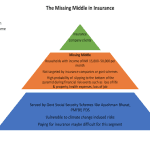Risk vs. Resilience: Insuring Sustainable African Cities in the Age of Climate Change
Though much of the global conversation is, understandably, focused on the COVID-19 pandemic, climate change continues to have devastating effects on communities, businesses and governments around the world. For instance, in 2018 alone, there were 53 climate-related disasters in Africa, which caused economic losses totalling $1.3 billion and insured losses totalling $0.2 billion, even prior to Cyclone Idai. And these disasters are likely to get worse: Africa is expected to experience rises in temperatures of between 0.2 and 0.5 degrees Celsius per decade, which will cause increased variability in rainfall patterns and a rise in extreme weather events.
Of the various types of natural disasters experienced, flooding causes the most severe economic impact. Since 2000, floods have been responsible for 64% of disaster events in Africa, and have affected 72 urban areas. In sub-Saharan Africa (SSA), 654 floods have affected 38 million people with around 13,000 deaths recorded from 1981-2014. These numbers too are likely to increase, as Africa’s coastal cities face an additional risk of flooding due to rising sea levels. In SSA, there are 320 coastal cities that have 100,000 or more inhabitants, and more than 56 million people live in vulnerable, low- elevation coastal zones. By 2100, seven African countries are predicted to face damages of more than $1 billion per year under a mid-range sea-level rise scenario.
The Challenges of Urbanisation in Africa
Adding to the concern surrounding flooding in cities, Africa is also the fastest-urbanising continent in the world: Its urban population is projected to reach 1.2 billion by 2050, which means that 60% of all Africans will be living in cities by then. Rapid urbanisation and uncontrolled urban growth, insufficient waste management and poor drainage systems exacerbate flood risks in African cities. Meanwhile, urban population growth has already outpaced the capacity of the authorities to maintain and expand infrastructure and provide essential services. Insufficient land and housing provision mean that about 53 million people – half the urban population – in SSA live in urban slums. These individuals are disproportionately affected by climate disasters, as they lack the resources to cope with these risks.
Cities and their inhabitants’ health and livelihoods need to be prioritized, as they are the main drivers of economic growth on the continent. In SSA, 143 cities generate a combined $0.5 trillion per year, or 50% of the region’s gross domestic product. Thus, natural disasters in urban areas have a direct economic impact – not only on the urban poor, but also on the rural communities that depend on them as markets for their produce or as remittance senders. For this reason, urban resilience is a critical element of sustainable development, involving the cities themselves as well as the infrastructure that serves and connects them. More resilient cities contribute to development regardless of whether disaster strikes, by avoiding losses, unlocking economic potential by de-risking investment, and improving risk mitigation and management.
How to build more resilient cities
But unfortunately, African cities lack the resources to fund risk mitigation and support post-disaster recovery. And the current insurance business model for underwriting physical assets in cities and urban infrastructure is increasingly at risk. Experienced losses exceed predicted losses, and climate-driven disasters are exacerbated by infrastructure and city planning limitations. In several cities, including Lagos and Accra, insurance policies are starting to exclude flood cover as a result of the extent of exposure. When insurers deem such risks uninsurable or have to increase premiums to unaffordable levels, it has significant negative consequences for investment. To better manage these risks and continue to retain the insurance underwriting required for investment, collaborative action is needed. Local governments will need to work with insurers to manage critical urban infrastructure asset risks, and create new models and data to better understand and underwrite that risk.
We suggest four interventions that can help African underwriters to overcome these challenges and become drivers and enablers of climate-related mitigation and adaptation strategies. These measures will ultimately build resilience and create more sustainable, insurable African cities and infrastructure.
1. Generate evidence to underwrite for urban resilience
There is an evidence gap that makes it difficult to assess the critical constraints to underwriting for urban resilience – for Africa as a whole, as well as for specific regions and countries. Local evidence and global learning are needed to provide frameworks to understand the impact of disasters, and to determine who bears the cost, who manages the risk, and where the opportunities are to underwrite for urban risks within a broader risk management approach. Such evidence would underpin the business case for market and public sector actors to collaborate and invest in climate risk adaptation strategies. It would also be the first step toward understanding these areas’ insurance needs, and ultimately translating that need into demand for effective products to build resilience.
2. Develop data and risk models to shape products and collaboration
The existing risk models used by many underwriters are based on historic data and don’t take into account the science on future climate change, which limits their effectiveness in predicting losses from climate-related disasters. Further complicating this situation, the business case for developing such models for Africa is thin. However, we see an opportunity for African underwriters and their partners to collaborate to fill these data gaps, create metrics, and develop open data and new models that provide deeper insights into local risks – as well as harnessing global initiatives and innovations to better address African data and modelling gaps. We’ve seen some approaches that show early potential, such as those of Icebreaker One, which aims to unlock the data infrastructure needed to address climate change, and OasisHub, which is an open access platform for global environmental and risk data, tools and services (both free and commercial).
3. Create platforms for dialogue and action
Though evidence-building and data are essential, a better understanding of the risk, by itself, is insufficient to improve risk mitigation or adaptation. We believe it’s also important to create country-level or regional dialogue and establish multi-sector platforms that bring together the different groups that need to work together to solve climate change-driven disasters in Africa. For instance, the collaborative approach taken by underwriters and local government through the Partnership for Risk and Resilience programme in South Africa has helped bring together key actors to better understand and manage municipal risks.
4. Improve underwriters’ capacity to manage infrastructure risk
Underwriting capacity in Africa is limited. In response, the industry needs to develop these skills and better utilise them to build the resilience of cities. The United Nations Environment Programme – Finance Initiative’s Principles for Sustainable Insurance ESG underwriting guidelines provide an early tool to inform sustainable underwriting practices, which could serve as one model for these efforts. But even where these underwriting skills exist, insurers are often brought into infrastructure development or city planning at too late a stage to improve city or country risk management. Inspired by the Actuaries Without Borders programme, we believe it would be possible to create an “Underwriters Without Borders” initiative, whereby global underwriters could be enlisted to help evaluate, analyse and price disaster risks, identify appropriate risk mitigation strategies, and build local capacity for resilience.
Building the resilience of African cities is vital to the safety and productivity of the 2.2 billion people who will call Africa home by 2050. To enable that development, we need to invest in cities now – while reimagining their approach to mitigating and managing risks – if we want to build a more prosperous future for all.
Kate Rinehart-Smit is an associate and Mia Thom is a Technical Director at Cenfri, a NextBillion partner.
Photo courtesy of martinaH79.
- Categories
- Environment, Finance




